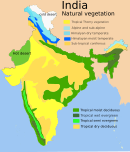
Agriculture in India has a significant history. Today, India ranks second worldwide in farm output. Agriculture and allied sectors like forestry and logging accounted for 16.6% of the GDP in 2007, % of the total workforce and despite a steady decline of its share in the GDP, is still the largest economic sector and plays a significant role in the overall social-economic development of India.
India is the largest producer in the world of fresh fruit, anise, fennel, badian, coriander, tropical fresh fruit, jute, pigeon peas, pulses, spices, millets, castor oil seed, sesame seeds, safflower seeds, lemons, limes, cow's milk, dry chillies and peppers, chick peas, cashew nuts, okra, ginger, turmeric guavas, mangoes, goat milk and buffalo milk and meat. India is also the largest producer of millets like Jowar Bajra and Ragi. It is second only to China in the production of rice. India is the 6th largest coffee producer in the world It also has the world's largest cattle population (281 million). It is the second largest producer of cashews, cabbages, cotton seed and lint, fresh vegetables, garlic, egg plant, goat meat, silk, nutmeg. mace, cardamom, onions, wheat, rice, sugarcane, lentil, dry beans, groundnut, tea, green peas, cauliflowers, potatoes, pumpkins, squashes, gourds and inland fish. It is the third largest producer of tobacco, sorghum, rapeseed, coconuts, hen's eggs and tomatoes. India accounts for 10% of the world fruit production with first rank in the production of mangoes, papaya, banana and sapota.
India's population is growing faster than its ability to produce rice and wheat.
Per the World Bank's "India Country Overview" in 2008:
"Slow agricultural growth is a concern for policymakers as some two-thirds of India’s people depend on rural employment for a living. Current agricultural practices are neither economically nor environmentally sustainable and India's yields for many agricultural commodities are low. Poorly maintained irrigation systems and almost universal lack of good extension services are among the factors responsible. Farmers' access to markets is hampered by poor roads, rudimentary market infrastructure, and excessive regulation."
— World Bank: "India Country Overview 2008"